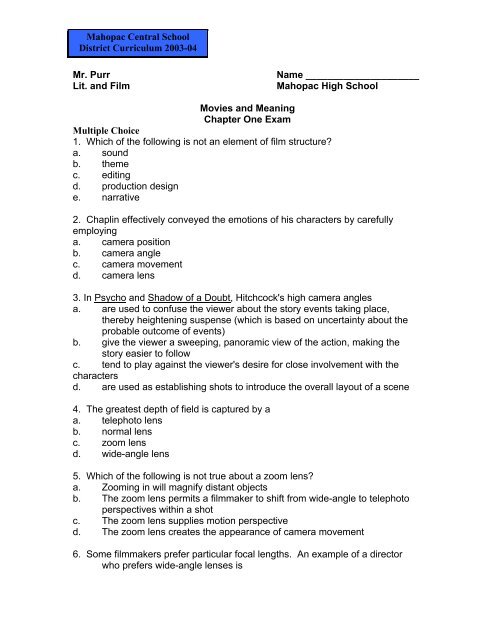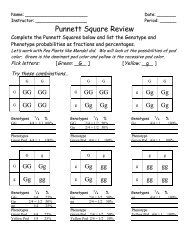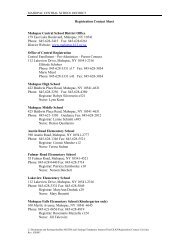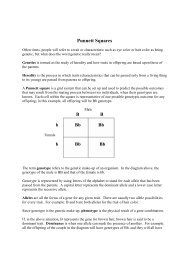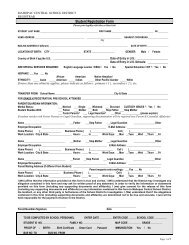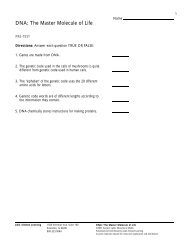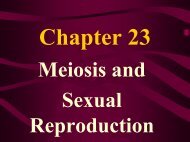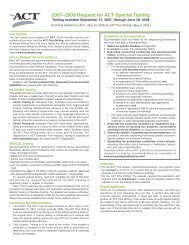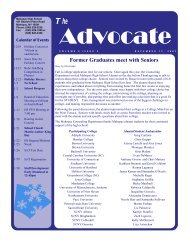77 kb - Mahopac Central School District
77 kb - Mahopac Central School District
77 kb - Mahopac Central School District
Create successful ePaper yourself
Turn your PDF publications into a flip-book with our unique Google optimized e-Paper software.
<strong>Mahopac</strong> <strong>Central</strong> <strong>School</strong><br />
<strong>District</strong> Curriculum 2003-04<br />
Mr. Purr<br />
Lit. and Film<br />
Name _____________________<br />
<strong>Mahopac</strong> High <strong>School</strong><br />
Movies and Meaning<br />
Chapter One Exam<br />
Multiple Choice<br />
1. Which of the following is not an element of film structure<br />
a. sound<br />
b. theme<br />
c. editing<br />
d. production design<br />
e. narrative<br />
2. Chaplin effectively conveyed the emotions of his characters by carefully<br />
employing<br />
a. camera position<br />
b. camera angle<br />
c. camera movement<br />
d. camera lens<br />
3. In Psycho and Shadow of a Doubt, Hitchcock's high camera angles<br />
a. are used to confuse the viewer about the story events taking place,<br />
thereby heightening suspense (which is based on uncertainty about the<br />
probable outcome of events)<br />
b. give the viewer a sweeping, panoramic view of the action, making the<br />
story easier to follow<br />
c. tend to play against the viewer's desire for close involvement with the<br />
characters<br />
d. are used as establishing shots to introduce the overall layout of a scene<br />
4. The greatest depth of field is captured by a<br />
a. telephoto lens<br />
b. normal lens<br />
c. zoom lens<br />
d. wide-angle lens<br />
5. Which of the following is not true about a zoom lens<br />
a. Zooming in will magnify distant objects<br />
b. The zoom lens permits a filmmaker to shift from wide-angle to telephoto<br />
perspectives within a shot<br />
c. The zoom lens supplies motion perspective<br />
d. The zoom lens creates the appearance of camera movement<br />
6. Some filmmakers prefer particular focal lengths. An example of a director<br />
who prefers wide-angle lenses is
<strong>Mahopac</strong> <strong>Central</strong> <strong>School</strong><br />
<strong>District</strong> Curriculum 2003-04<br />
a. Orson Welles<br />
b. Akira Kurosawa<br />
c. Alfred Hitchcock<br />
d. Charles Chaplin<br />
7. If a filmmaker wished to add visual energy to a scene by capturing a<br />
character's rapid motion in an exciting way, the filmmaker should employ a<br />
a. pan shot<br />
b. tilt shot<br />
c. tracking shot<br />
d. boom shot<br />
8. The perception of apparent motion on screen is most closely related to the<br />
factor of<br />
a. beta movement<br />
b. persistence of vision<br />
c. flicker fusion<br />
d. intermittent motion<br />
9. The elements of film structure<br />
a. tend to differ from, or transform, the viewer's real-world visual and social<br />
experience<br />
b. tend to correspond with the viewer's real-world visual and social<br />
experience<br />
c. tend to both transform, as well as correspond with, the viewer's real-world<br />
visual and social experience<br />
d. have little or no relation to the viewer's real-world experience because<br />
cinema is based on an illusion of motion and three-dimensions<br />
10. Chaplin's formula for guiding his camera placements can be stated as:<br />
a. use of a moving camera to follow motion<br />
b. high angle for comedy, eye-level angle for drama<br />
c. long shot for drama, close-up for comedy<br />
d. long shot for comedy, close-up for tragedy<br />
11. A filmmaker who frequently used camera position to play against the viewer's<br />
desire for emotional involvement with the reaction of a character is<br />
a. Charlie Chaplin<br />
b. Orson Welles<br />
c. Alfred Hitchcock<br />
d. Oliver Stone<br />
12. Hitchcock's most influential film was<br />
a. Psycho<br />
b. Rear Window
<strong>Mahopac</strong> <strong>Central</strong> <strong>School</strong><br />
<strong>District</strong> Curriculum 2003-04<br />
c. North by Northwest<br />
d. Frenzy<br />
13. This lens will produce a very small angle of view<br />
a. wide-angle<br />
b. telephoto<br />
c. normal<br />
d. none of the above<br />
14. The famous shot in Gone with the Wind where the camera moves up to a<br />
high angle to show a large group of wounded and dead soldiers at the<br />
railroad station is an example of a<br />
a. tilt<br />
b. dolly<br />
c. pan<br />
d. crane<br />
15. Cinematography occurs during the filmmaking stage of<br />
a. pre-production<br />
b. post-production<br />
c. production<br />
d. pre-visualization<br />
16. The chief artistic authority of a film production generally resides with the<br />
a. producer<br />
b. director<br />
c. editor<br />
d. the production team as a whole<br />
17. This camera angle is often used to make the world look off-kilter or to<br />
express a character's anxiety or disorientation<br />
a. low<br />
b. high<br />
c. bird's eye<br />
d. canted<br />
18. The area within the frame from foreground to background that remains in<br />
focus is the<br />
a. area of view<br />
b. angle of view<br />
c. area of focus<br />
d. depth of field<br />
19. To make objects on screen seem closer to the camera than they really are, a<br />
filmmaker would use
<strong>Mahopac</strong> <strong>Central</strong> <strong>School</strong><br />
<strong>District</strong> Curriculum 2003-04<br />
a. a wide-angle lens<br />
b. a telephoto lens<br />
c. a normal lens<br />
d. a magnifying lens<br />
20. This lens often facilitates the staging of stunts:<br />
a. a wide-angle lens<br />
b. a telephoto lens<br />
c. a normal lens<br />
d. a magnifying lens<br />
21. This filmmaker is often credited with discovering the artistic potential of the<br />
moving camera:<br />
a. Orson Welles<br />
b. Alfred Hitchcock<br />
c. Charles Chaplin<br />
d. F.W. Murnau<br />
22. Steven Spielberg and his cinematographer on Saving Private Ryan used<br />
some unusual filmic techniques, including all of these EXCEPT<br />
a. flashing<br />
b. ENR<br />
c. mixing black and white with color film<br />
d. lenses that had been stripped of their protective coating<br />
23. "Virtual cinematography" in The Matrix consisted of creating an illusion of<br />
a. depth of field<br />
b. camera movement<br />
c. camera angle<br />
d. telephoto perspective<br />
24. On A.I.: Artificial Intelligence, Steven Spielberg and cinematographer Janusz<br />
Kaminski used cool colors and wide-angle lenses to evoke the style of this<br />
director, who had originally planned to make the film:<br />
a. Steven Soderbergh<br />
b. Orson Welles<br />
c. Alfred Hitchcock<br />
d. Stanley Kubrick<br />
Essay<br />
Answer two of the following :<br />
1. Explain the concept of film structure and the role of the director in relation to<br />
the task of structural design.
<strong>Mahopac</strong> <strong>Central</strong> <strong>School</strong><br />
<strong>District</strong> Curriculum 2003-04<br />
2. What is aspect ratio, and what happens when widescreen ratios must be<br />
reformatted for television<br />
3. Explain the different optical characteristics of telephoto and wide-angle<br />
lenses.<br />
4. How does cinema correspond with, and transform, the viewer's real-world<br />
visual and social experience<br />
5. What are the characteristics of pan and tilt shots, tracking shots and crane<br />
shots


